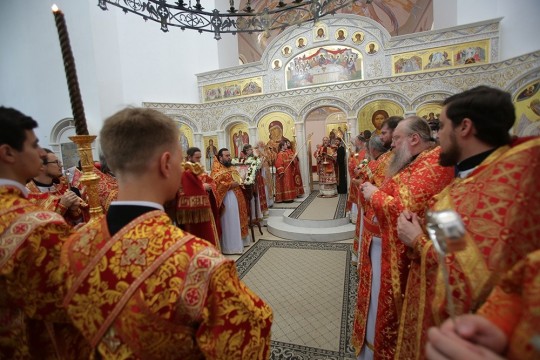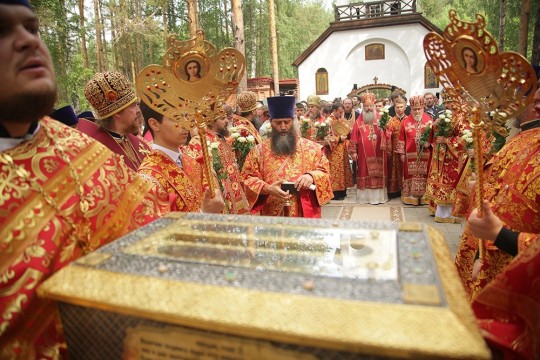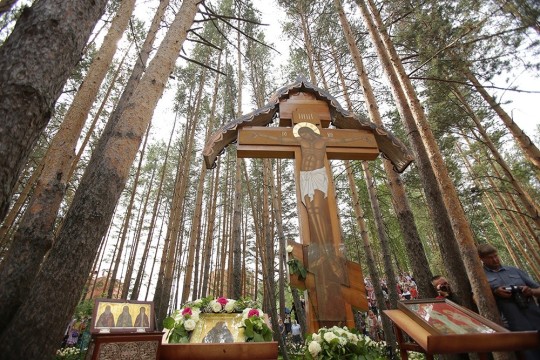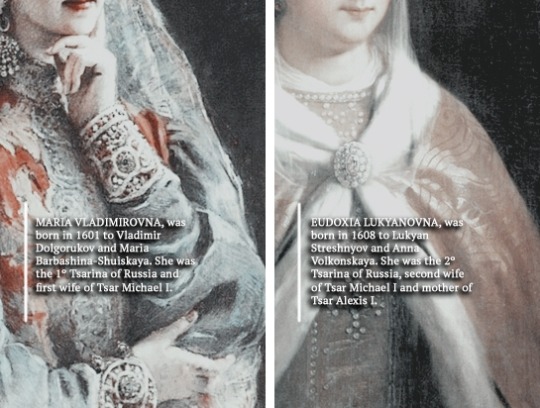#Tsarina maria vladimirovna
Explore tagged Tumblr posts
Text








Empresses Consorts of the Romanov Family {01/16}: Maria Vladimirovna Dolgorukova.
"Maria Dolgorukova was born to the nobleman Knyaz Vladimir Timofeevich Dolgorukov and Princess Maria Vasilyevna Barbashina-Shuiskaya. She was chosen to marry Michael by his mother, Ksenia Shestova, after several years of struggle to find a partner for the tsar. In 1623, Ksenia Shestova chose Maria Dolgorukova as her marriage partner because of her family connections. Her sister was married to Prince Ivan Shuisky Botan, younger brother of the last Rurik dynasty, Vasily IV. The wedding took place on September 19, 1624. Shortly after the wedding, Tsaritsa Maria became ill. She finally died on January 17, 1625, four months after her wedding. At the time, there were rumors that she had been poisoned by a fraction or an enemy of the Dolgorukov family in order to thwart the influence of the pro-Rurikids at court. The funeral was held on January 18th. Her coffin was covered with deep red English cloth. The funeral was ordered by her cousin Prince Bogdan Dolgorukov and priest Vasily Semyonov. Maria Vladimirovna was buried in the tomb of the Russian Tsarinas, in the cathedral of the Ascension Monastery, behind the column on the left by the west door."
Academic accelerator.com
(Movie: Godunov - 2018)
#tsarina maria vladimirovna#more romanovs#facts#my own#godunov 2018#Empress consort of russia#imperial russia#romanov family#tsarina#the romanovs#maria vladimirovna#maria vladimirovna dolgorukova#maria dolgorukova
8 notes
·
View notes
Text






Borne to God on Angelic Hymns
Photos from the 100th Anniversary Celebration of the Martyrdom of St. Elizabeth the Grand Duchess and Those With Her
A host of bishops of the Russian Orthodox Church celebrated the 100th anniversary of the martyrdom of St. Elizabeth the Grand Duchess, the Nun Barbara, and Grand Duke Sergei Mikhailovich Romanov, the Princes Ioann Konstantinovich, Konstantin Konstantinovich, Igor Konstantinovich, and Vladimir Pavlovich Paley, and Grand Duke Sergei's secretary Fyodor Remez martyred with them yesterday at the site of their martyrdom.
The celebration followed the festivities in honor of the 100th anniversary of Tsar Nicholas II, Tsarina Alexandra, and their children and faithful servants the day before in Ekaterinburg. St. Elizabeth the New Martyr was the sister of Tsarina Alexandra.
The service in honor of Sts. Elizabeth, Barbara, and those with them was headed by His Eminence Metropolitan Kirill of Ekaterinburg and Verkhotursky, with the concelebration of twelve other hierarchs and the clergy of the Metropolitanate of Ekaterinburg.
Following the service, the hierarchs, clergy, and faithful processed to the mine where the bodies of the holy martyrs were thrown on the night of July 17-18, 1918. A moleben was celebrated at the mine, followed by the singing of the Cherubic Hymn, which the martyrs sang throughout the course of several days within the mine until they finally departed to the Heavenly Kingdom. As the hymn was being sung, the mine, which has become a place of pilgrimage for hundreds of thousands from throughout the world, was censed. Particles of the relics of St. Elizabeth were brought out of the church for veneration.
Met. Kirill of Ekaterinburg then addressed the congregation with an archpastoral homily:
For us, believers, today is the day of our personal relationship to Elizabeth Feodorovna and to all the martyrs of the Russian Church and Russian land, who … now defend holy Orthodoxy so our people might live not under the seal of the Satanism, but under the blessing of God. And today, when we incline our heads and the knees of our hearts at this mine, we see the meek face of Elizabeth Feodorovna and her loving heart, which forgives all: the killers and their successors, and prays for all—for our people, and for us today, that this cruelty, this antipathy, this lack of understanding of one another has finally gone from our lives, and we have again become one, great, powerful Russian people, the name and banner of which is the banner of Christianity and the name of Christianity, and the protection of which is the saints of God, who stand before the throne of God today for our infirmity, tearfully praying for us, for our lives, bitter and often unjust.
Among other guests, the service was attended by the head of the Russian Imperial House of Romanov, Grand Duchess Maria Vladimirovna and her son and other members of the Romanov family.
Photos: The Diocese of Ekaterinburg Text: OrthoChristian.com
12 notes
·
View notes
Photo

ETYMOLOGY: Olga
The name is of Scandinavian origin, spelled in Cyrillic as Ольга. It is the female form of ‘Oleg’, a name that means “holy” or “blessed”. It is a name commonly used by Russian descendants such as:
HM Queen Olga of Greece [born HIH Grand Duchess Olga Constantinovna, she was the consort of the Danish George I of Greece. Among her grandchildren are GD Dmitri Pavlovich, Prince Philip, GD Cecilie, and Princess Marina.]
HRH Olga of Greece and Denmark, Princess Paul of Yugoslavia [eldest daughter of GD Elena Vladimirovna and Prince Nicholas of Greece, she is the sister of the Duchess of Kent Princess Marina.]
HIH Grand Duchess Olga Nikolaevna Romanova [eldest of the four daughters of Tsar Nicholas II and Tsarina Alexandra]
HIH Grand Duchess Olga Alexandrovna Romanova [daughter of Tsarina Maria Feodorovna, and sister of Tsar Nicholas II]
#queen olga of greece#queen olga#olga constantinovna#gd olga constantinovna#princess olga#princess paul#olga of yugoslavia#princess olga of yugoslavia#princess olga of greece#gd olga#gd olga nikolaevna#olga nikolaevna#gd olga alexandrovna#olga alexandrovna#russia#imperial russia#greece#yugoslavia#etymology#olga
50 notes
·
View notes
Photo

This is Maria Vladimirovna, Grand Duchess of Russia. Maria is my cousin and I love her to pieces. A few months ago she was offered the chance to be Tsarina of Russia but turned it down. I accepted it knowing the historical significance of it. I’m proud to be Tsarina but sometimes wish that my cousin could guide me more. I wouldn’t change my cousin for the world. I’m so glad that Maria, Franz Wilhelm & her son George are happy with they’re lives. Happiness in this family is all that we care about. As long as we have each other that’s all that matters. #mariavladimirovna #grandduchessofrussia #romanovfamily #familyhistory #royalhistory #royalnewsupdate
0 notes
Photo








Tsarinas Consorts of the Romanov House.
Maria Vladimirovna - Maria was born in 1601 and was the first wife of Tsar Michael I. She was selected for marriage to Michael by his mother, Xenia Shestova, after several years of difficulty of finding a partner for the Tsar. The wedding took place on 19 September 1624. Not long after the wedding, the Tsarina took ill. She died on 17 January 1625, four months after the wedding. There were rumors at the time that she had been poisoned by fractions at court determined to prevent any potential pro-Rurikid influence, or by the enemies of her father’s family.
Eudoxia Lukyanovna - Eudoxia was born in 1608 and was the second wife of Tsar Michael I. She was among those daughters of the nobility summoned to appear in the Bride-show at court, when the tsar was to select his new tsaritsa, after his first spouse had died. He eventually chose Eudoxia because of her beauty, polite behavior and mild disposition. She was described as a modest and virtuous girl, dominated by her proud relatives, who sometimes brought her to tears but still did not complain. The wedding was conducted on 5 February 1626. After the wedding, she was given several lands, and a substantial fortune of her own. Eudoxia and Michael became parents of 10 children, including the future Tsar Alexei I.
Maria Ilyinichna - Maria was born in 1624 and was the first wife of Tsar Alexei I. The tsar was to choose his bride from a bride-show of hundreds of daughters of the nobility, Maria was selected as the tsar's second choice after his first choice to marry Euphemia Fedorovna Vsevolozhskaya was annuled. Maria was reportedly a beauty. The wedding was conducted in 16 January 1648 in Moscow and the union is described as a happy one. The couple had 13 children, including Tsar Feodor III of Russia, Tsar Ivan V of Russia, and the Princess Regent Sophia Alekseyevna.
Natalya Kirillovna - Natalya was born in 1651 and was the second wife of Tsar Alexei I. In March 1669, Tsar Alexis’ first wife, Tsarina Maria, died during the birth of what would have been their fourteenth child. The Tsar supported by the Russian public, although not by the family of Maria, decided to remarry in the hope of producing more potential heirs. The tsar arranged an inspection of women he considered eligible in early 1670, Natalya was added to this inspection following an encounter with the tsar at the home of her adoptive father, Artamon Matveyev. Alexis was impressed by Natalya's beauty, and selected her to be his bride without needing to go ahead with a planned second inspection. The couple married on 1 February 1671. Alexis and Natalya had a happy marriage, spending much of their time together in various palaces and villas around Moscow. The couple became parents of the future Tsar Peter the Great.
Agafiya Semyonovna - Agafiya was born in 1663 and was the first wife of Tsar Feodor III. In 1680, Tsar Feodor, saw her during a religious procession: when she fainted after the sight of a witch in a religious theater play he rushed forward to support her, and fell in love with her. Aware that her uncle did not wish her to marry, a traditional summon was proclaimed to all unmarried noble women to gather for Feodor to choose from, and he chose her. On 18 July 1680, she married Feodor. Agafya has been described as merciful and loyal to her husband and the public's welfare. She could speak and write Polish, French and Latin and was well informed about the Western European life style. She could also play harpsichord. She was described as beautiful as "an angel of heaven", with an easy going character. She was the first to advocate beard-shaving and the adoption of Western clothes at the Russian court. She herself was the first Tsarina to expose her hair and to wear a Western (Polish) dress. Agafya died as a consequence of the childbirth, and six days later, the nine-days-old Tsarevich Ilya also died. She was reportedly deeply mourned by Feodor.
Marfa Matveyevna - Marfa was born in 1664 and was the second wife of Tsar Feodor III. She was the daughter of Matvey Vasilyevich Apraksin and Domna Bogdanovna Lovchikova. She and Feodor were married on 14 February 1682, and he died only a few months later in April.
Praskovya Fyodorovna - Praskovya was born in 1664 and was the only wife of Tsar Ivan V. The marriage of Ivan V was arranged by his sister, the regent Sophia. Ivan V himself reportedly showed no inclination toward marriage and according to the Swedish diplomat Hildebrandt Horn, Praskovia was not willing to marry Ivan, but was forced to consent. The wedding took place on 9 January 1684, with the Patriarch John officiating as the ceremony. Praskovia Saltykova was at the time of her marriage described as a healthy Russian beauty, tall, with a full figure and long thick hair, as a person, she was described as religious, superstitious and not very well educated. Praskovya and Ivan had five daughters including Empress Anna of Russia.
Eudoxia Feodorovna - Eudoxia was born on 1669 and was the first wife of Tsar Peter I (the Great). She was chosen as a bride for the Tsar by his mother Natalya. She was crowned Tsarina in 1689. The Tsar could not stand her conservative relatives and soon abandoned her for a Dutch beauty, Anna Mons. Eudoxia's letters to Peter were full of complaints and exhortations of unrequited love. She was the paternal grandmother of Peter II of Russia.
Catherine Alexeyevna - Catherine was born on 1684 and was the second wife of Tsar Peter I (the Great). She was originally named Marta Helena Skowrońska, In 1705,she converted to Orthodoxy and took the new name of Catherine Alexeyevna. Afterwards she became part of the household of Prince Alexander Menshikov, who was the best friend of Peter the Great of Russia. Anecdotal sources suggest that she was purchased by him. In 1704, she was well established in the Tsar's household as his mistress, and gave birth to a son, Peter. Though no record exists, Catherine and Peter are described as having married secretly in St. Petersburg in 1707. Peter married her again (this time officially) at Saint Isaac's Cathedral in St. Petersburg in 1712; she took the style of her husband and became Tsarina. They had 12 children. Peter died on 1725 without name a successor and Catherine was chosen as Empress Regnant.
Catherine Alekseyevna - Catherine was born in Prussia as Princess Sophie of Anhalt-Zerbst on 1729 and was the only wife of Tsar Peter III. The choice of Sophie as wife of her second cousin, the prospective Tsar Peter, resulted from some amount of diplomatic management in which Count Lestocq, Peter's aunt (and the ruling Russian Empress) Elizabeth and Frederick II of Prussia took part. Lestocq and Frederick wanted to strengthen the friendship between Prussia and Russia to weaken Austria's influence and ruin the Russian chancellor Bestuzhev, on whom Empress Elizabeth relied, and who acted as a known partisan of Russo-Austrian co-operation. The diplomatic intrigue failed, largely due to the intervention of Sophie's mother, Johanna Elisabeth of Holstein-Gottorp. Historical accounts portray Johanna as a cold, abusive woman who loved gossip and court intrigues. Despite Johanna's interference, Empress Elizabeth took a strong liking to Catherine, who, on arrival in Russia in 1744 spared no effort to ingratiate herself not only with Empress Elizabeth, but with her husband and with the Russian people as well. The long-planned dynastic marriage finally occurred on 21 August 1745 in Saint Petersburg. Sophie had turned 16; The newlyweds settled in the palace of Oranienbaum, which remained the residence of the "young court" for many years to come. In 1762 Peter died and Catherine took the throne as Catherine II. Peter and Catherine were parents of Tsar Paul I.
Maria Feodorovna - Maria was born in Prussia as Duchess Sophie Dorothea on 1759 and was the second wife of Tsar Paul I. In 1776, when Grand Duke Paul (the future Paul I of Russia), became a widower, Sophie Dorothea was chosen by Frederick II of Prussia, her maternal great uncle, and by Empress Catherine II of Russia, as the ideal candidate to be Paul’s second wife. They met in a state dinner in Berlin and their engagement was quickly arranged.Sophie Dorothea arrived in St Petersburg that September, converted to the Russian Orthodox Church, and took the name Maria Feodorovna. She married Paul on 26 September 1776. In spite of her husband's difficult character, Maria Feodorovna made a success of her marriage. Paul and Maria lived at Gatchina. They were devoted to each other and had ten children including: Tsar Alexander I, Tsar Nicholas I of Russia, Grand Duchess Maria of Saxe-Weimar-Eisenach, Queen Catherine of Wurttemberg and Queen Anna of the Netherlands.
Elizabeth Alexeievna - Elizabeth was born on 1779 in Germany as Princess Louise Maria Auguste of Baden and was the only wife of Tsar Alexander I. Catherine the Great was looking for a bride for her eldest grandson, the future Alexander I, and set her eyes on the Princesses of Baden, so Catherine invited Princess Louise and her younger sister Frederica, who later became Queen of Sweden, to Russia. In the autumn of 1792, the two sisters arrived in St. Petersburg. The Empress was delighted by Louise, finding her a model of beauty, charm, and honesty. Louise herself was attracted to Alexander, who was handsome. At first, Alexander was shy with his future bride — very young and inexperienced, however, the young couple soon grew fond of each other. The Princess learned Russian and converted to the Orthodox Church. The wedding took place on 28 September 1793. "It was a marriage between Psyche and Cupid", Catherine wrote to the Prince of Ligne. Elizabeth was only fourteen, her husband a year older.
Alexandra Feodorovna - Alexandra was born in Berlim as Princess Friederike Luise Charlotte Wilhelmine of Prussia on 1798 and was the only wife of Tsar Nicholas I. In 1814, Nicholas Pavlovich, future Tsar of Russia, and his brother Michael Pavlovich, visited Berlin. Arrangements were made for Nicholas to marry Charlotte, then fifteen years old, to strengthen the alliance between Russia and Prussia. On a second visit the following year, Nicholas fell in love with the then-seventeen-year-old Princess Charlotte. The feeling was mutual, "I like him and am sure of being happy with him." She wrote to her brother. On June 1817 Charlotte came to Russia with her brother William. After arriving in St. Petersburg she converted to Russian Orthodoxy, and took the Russian name "Alexandra Feodorovna". On her nineteenth birthday, on July 1817, she and Nicholas were married in the Grand Church of the Winter Palace. The couple had 7 children including Tsar Alexander II.
Maria Alexandrovna - Maria was born as Princess Maximiliane Wilhelmine Auguste Sophie Marie of Hesse and by Rhine on 1824 and was the first wife of Tsar Alexander II. In 1839, the Tsarevich Alexander, traveled to western Europe to complete his education and to search for a wife. He stopped for one day in Darmstadt during the evening, invited to the Opera house by the Grand Duke of Hesse, Alexander was introduced to Princess Marie. Alexander was smitten by her. In June of 1939, he returned to Darmstadt to seal his engagement with Princess Marie. The Princess was received into the Russian Orthodox Church on December 1840 and became Grand Duchess Maria Alexandrovna. The wedding took place on 28 April, 1841. The couple had 8 children including Tsar Alexander III.
Maria Feodorovna - Maria was born on 1847 at Denmark as Princess Marie Sophie Frederikke Dagmar and was the only wife of Tsar Alexander III. In 1864, Tsarevich Nicholas went to Denmark where he was betrothed to Dagmar. On April 1865 he died from meningitis. His last wish was that Dagmar would marry his younger brother, the future Alexander III. Dagmar was distraught after her young fiancé's death. The disaster had brought her very close to "Nicholas’" parents, and she received a letter from Alexander II in which the Emperor attempted to console her. In June 1866, while on a visit to Copenhagen, the Tsarevich Alexander asked Dagmar for her hand. They had been in her room looking over photographs together. She converted to Orthodoxy and became Grand Duchess Maria Feodorovna. The wedding took place on November 1866 in the Imperial Chapel of the Winter Palace in Saint Petersburg. The couple had 6 children including Tsar Nicholas II.
Alexandra Feodorovna - Alexandra was born on 1872 in Darmstadt as Princess Alix Viktoria Helene Luise Beatrix of Hesse and by Rhine and was the only wife of Tsar Nicholas II. Nicholas and Alix had first met in 1884 at the wedding of Nicholas's Uncle Sergei and Alix's sister Elisabeth in St. Petersburg. When Alix returned to Russia on a several week visit in 1889, the two young people fell in love. Initially Nicholas's father, Tsar Alexander III, refused the prospect of their marriage. Alexander and his wife were both vehemently anti-German, and did not want the match with Princess Alix. While in good health, Alexander III ignored his son's demands, but began to relent when his health began to fail. In 1894 Nicholas proposed to Alix. She initially rejected him on the grounds of her refusal to convert to Orthodoxy. However, after pressure from the Kaiser, who had told her that it was her duty to marry Nicholas she accepted his second proposal. Alexandra and Nicholas were wed in the Grand Church of the Winter Palace of St Petersburg on 26 November 1894. The marriage that began that night remained exceptionally close until the pair was assassinated in 1918. The marriage was outwardly serene and proper, but based on intensely passionate physical love.
#Tsarina maria vladimirovna#tsarina eudoxia#tsarina maria ilyinichna#tsarina natalya#tsarina agafiya#tsarina marfa#Catherine the Great#catherine i#tsarina maria alexandrovna#tsarina maria feodorovna#elizabeth alexeievna#maria feodorovna#tsarina alexandra#empress alexandra
150 notes
·
View notes
Photo








Consorts of the Romanov dynasty.
#Tsarina maria vladimirovna#tsarina eudoxia#tsarina agafiya#tsarina marfa#tsarina natalya#tsarina maria ilyinichna#praskovia feodorovna#eudoxia feodorovna#catherine i#catherine the great#empress elizaveta alexeievna#empress maria feodorovna#Empress alexandra#tsarina maria alexandrovna#maria feodorovna#tsarina alexandra#my own#my edits
130 notes
·
View notes